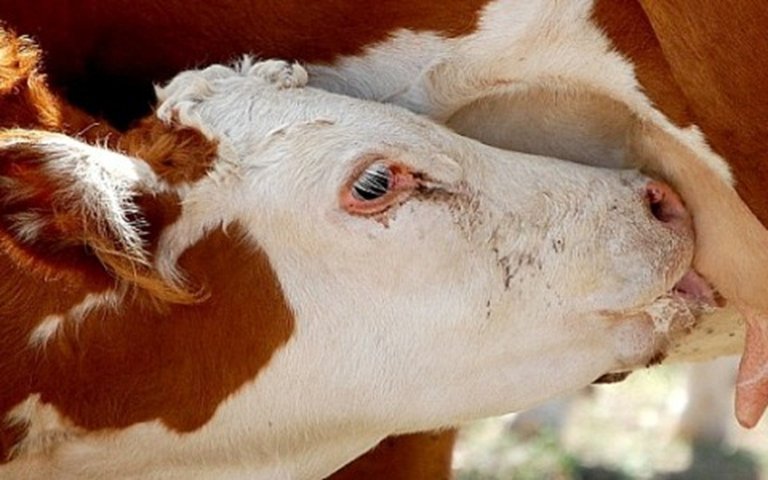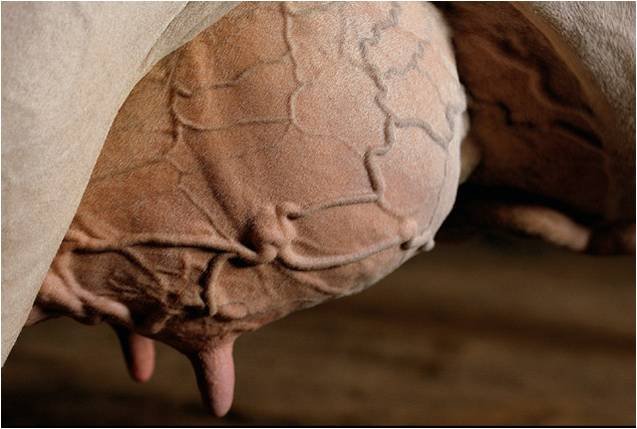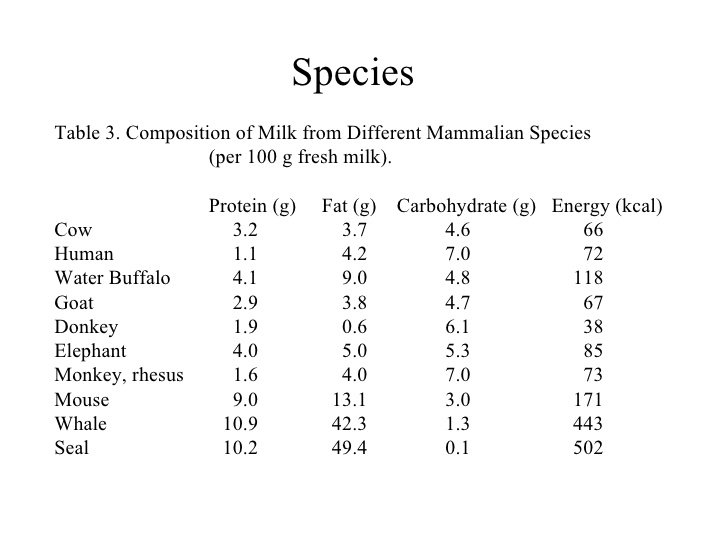Here you have a calf, drinking from it´s mother, and that is a good thing. That´s how a calf grows. This is a good normal dairy cow.

This other animal, is quite large. It has been genetically selected to give large quantities of milk.

A good dairy cow can produce 40 liters of milk a day, and a supersonic dairy cow, can produce 80 liters of milk a day, and the world champions cow, can produce 120 liters of milk a day, and it needed to wear a special harness, or the weight would tear this very structure of the animal, not the animal, but the blood vessels would tear in the process. This is not really a natural thing today any more. But I want to deal whit the product itself, dairy product. How healthy are they? We are told by the world out there, that we most have dairy in order to satisfy our calcium need, growing children’s need´s, and some energy rich food, and there is no doubt about it. One can grow very rapidly on dairy. And milk, we are told that we need milk because it contained calcium, and it contains proteins, and it contains all the things that we need. We also know that there are problems with it, and there are high concentrations of fat, and cholesterol, so some people are advised to take skim milk, rather than milk.
So, is this true, and how good is milk really? Well the industry has a huge marketing drive, and to compete in dairy industry in terms of marketing, it’s really quite something. There also have the law on their side, and they seem to believe that the word milk belongs to them, and in some countries you may not name any alternative products, milk. You must name it something else. So in some countries you may not say soy milk for example, you may call it soy drink or whatever, because the dairy board will take you to court, if you use the word milk. Well I’m going to use some publications here, to show you what the scientific world is saying of this.

Casein is the protein you find in milk. And there is a huge production of milk, so if you make evaporated products, there is an excess of casein in the world, and you can find casein in about any thing, any products, from cookies to baking, to power drinks, any thing, you name it. You would find casein. And casein is species especific, Is a very especific feeding protein, is a very compact protein and it need very especial circumstances for digestión. So casein for example needs a special enzyme, which would unraveld it, so that it can be cleave in a normal digestión process. And in infants or in calfs, the product that would do that is call renant, and renant curdle the milk and opens up the molecules for digestión.
So animal will produce this, other in the lining of the gut. You would find pigs producing this, and calf produce this, and you can use this renant as well as an extract, in the cheese production because it will help to curdle the milk. So casein is pretty species. Especific aminoacid composition, in diferent species is diferent, but of all, human mammals has the lowest protein content and the lowest ratio of casein to whey. So if you are going to compare them for example, you will find that in the human there are 1.2 mg per liter of casein, that´s what there is. And the time required to double the birth weight is 120 days. If you go to the horse, you see the horse has double the amount of casein or protein in general 2.4 mg per liter, and to double weight, is 60 days. Exactly half. Cow has 3.3 mg per liter, and the time to doubling weight is 47 days. and so on.

So, if protein is the reason way we drink milk, then the best milk to drink is rat milk. No doubt about it. Is another problem that we have over here. Will see that the human takes the longest to double the birth weight. Now, when a human is born, the moment the baby is born he gets up and he walks around and say where is the food right? No, he doesn’t do that. What does he do? Is totally helpless, and the brain is still developing, the nerves are still connecting up, so the baby is still uncoordinated, and the nervous system has to develop of the birth in a human. A human is a species where the brain is paramount. A cow is not so interested in school and calculous.Is more interested in walking around and feeding. Is that correct? And so, the food type that is geared for a cow is one to make muscles skeletal development, and is not geared for brain development. So, if we feed the human, cow’s milk, then what we can do is induce fairly rapid growth, but is muscles skeletal growth, and so the baby can get very large, very quickly, and smaller infants are frown upon that grows slightly slower. On the other hand, what is it that you would really want to develop properly, the brain or muscles skeletal development? Unless you want a champion boxing whatever. The point is, that human milk which have the lowest ratios of casein to whey, is geared for brain development. What is the brain consisting of? High levels of protein on the brain consist largely of fat. Basically, our brain is fatty tissue. And there are lots and lots of fatty components, around each of the nerves fibers which are particular fat molecules, and the brain connecting tissues or nerve tissues, are largely fatty tissues. And so, you need that type of development. Children that are raised on cow milk has a lower IQ than children that are raised on mother´s milk. That´s just a fact. If you work with animals in a zoo, you would know that you can’t feed any milk to any animal, normally it would day. A human is so resilient, that he could coup with just about any milk that is out there, and that´s way we believe that cow milk might be good for infants. In fact, the opposite is the truth.


So, there are other problems with milk as well, in terms of its purity. Now, way should an infant bleed internally if he gets cow milk? The answer again lays in the protein. The casein that occurs in the cow´s milk is very hard to digest. Which will mean that the situation inside the gut is such, that it is more acidic than normal, and very irritating to the intestine, so that the young intestine actually bleed in the process, and looses iron that way. And adults have the same problems. People that have ulcers, should never, never have dairy products in their systems because of the irritating nature of the digestive process involved.

Ok. So, what does that mean now? The first problem about dairy products, is the type of protein. The protein casein is very hard to digest, you need very special enzymes in order to do it, and mother´s milk has human casein, and the baby would find that hard to digest, but the mother has nodes in the Brest where bacteria are raised, which are call Bacillus Bifidus, and these bacterium is injected together with the milk, and help to digest the casein, and then the infants also, have small amounts of renant. In the cow on the other hand, the calf, produces large amounts of renant to coup with this huge amount of casein. So, that´s the way we deal with casein. Now, there is another problem, and that´s the sugar in milk. You see, the sugar in milk is lactose, and to digest the lactose, you need an enzyme named lactase. And the lactase is an enzyme that occurs and until it is weaned in the majority of the population. And the white populaces, and in the generally European stock population, that have lived in cold climate for many, many centuries, and where people have been raised on milk for a long, long time, because that´s all they had, they used to plant their grazing in the winter, and in the summer harvested. And they will have their cows, and their sheeps, and that´s what they were live off, throughout those winters. Dairy, dairy, dairy, that was the staple food of the European.
And so, in the European the enzyme lactase continues to produce after the weaning time, just because the milk has never been withdrawn from the diet. But in other nations this enzyme ceases to produce after the weaning time. The enzyme lactase, split the sugar lactose in to its two components. One is glucose, and the other one is galactose. Now galactose is one half of lactose. In an infant, there is another enzyme which would change galactose into glucose, so that he can use it. So, there is an enzyme, Beta Galactosidase, which would take this galactose and change it to glucose, as the baby needs it. And guess what happens when you are and adult, that enzyme stops been produce. Once you are weaned, you don’t produce it any more.
Continue...
very interesting
Congratulations @azulzenit! You have completed some achievement on Steemit and have been rewarded with new badge(s) :
Click on any badge to view your own Board of Honnor on SteemitBoard.
For more information about SteemitBoard, click here
If you no longer want to receive notifications, reply to this comment with the word
STOPIf you want to support the SteemitBoard project, your upvote for this notification is welcome!
Well described